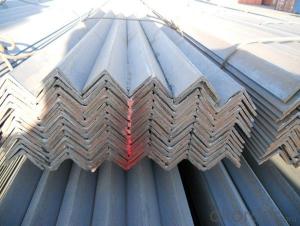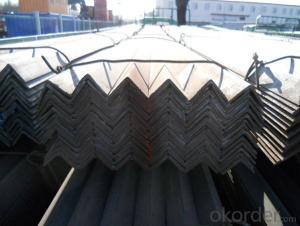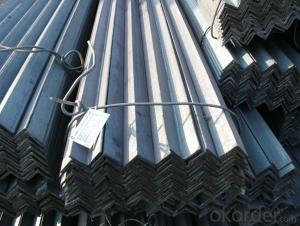High Quality Steel Angle Beams for Structure of Construction
- Loading Port:
- Tianjin
- Payment Terms:
- TT or LC
- Min Order Qty:
- 25 m.t.
- Supply Capability:
- 200000 m.t./month
OKorder Service Pledge
OKorder Financial Service
You Might Also Like
Product Description:
OKorder is offering High Quality Steel Angle Beams for Structure of Construction at great prices with worldwide shipping. Our supplier is a world-class manufacturer of steel, with our products utilized the world over. OKorder annually supplies products to African, South American and Asian markets. We provide quotations within 24 hours of receiving an inquiry and guarantee competitive prices.
Product Applications:
High Quality Steel Angle Beams for Structure of Construction are ideal for structural applications and are widely used in the construction of buildings and bridges, and the manufacturing, petrochemical, and transportation industries.
Product Advantages:
OKorder's High Quality Steel Angle Beams for Structure of Construction are durable, strong, and wide variety of sizes.
Main Product Features:
· Premium quality
· Prompt delivery & seaworthy packing (30 days after receiving deposit)
· Can be recycled and reused
· Mill test certification
· Professional Service
· Competitive pricing
Product Specifications:
Manufacture: Hot rolled
Grade: Q195 – 235
Certificates: ISO, SGS, BV, CIQ
Length: 6m – 12m, as per customer request
Packaging: Export packing, nude packing, bundled
EQUAL ANGLES SIZES |
| ||
a(mm) | a1(mm) | thickness(mm) | length |
25 | 25 | 2.5---3.0 | 6M/12M |
30 | 30 | 2.5---4.0 | 6M/12M |
38 | 38 | 2.5 | 6M/12M |
38 | 38 | 3.0---5.0 | 6M/12M |
40 | 40 | 3.0---6.0 | 6M/12M |
50 | 50 | 3 | 6M/12M |
50 | 50 | 3.7---6.0 | 6M/9M/12M |
60 | 60 | 5.0---6.0 | 6M/9M/12M |
63 | 63 | 6.0---8.0 | 6M/9M/12M |
65 | 65 | 5.0---8.0 | 6M/9M/12M |
70 | 70 | 6.0---7.0 | 6M/9M/12M |
75 | 75 | 5.0---10.0 | 6M/9M/12M |
80 | 80 | 6.0---10.0 | 6M/9M/12M |
90 | 90 | 6.0---10.0 | 6M/9M/12M |
100 | 100 | 6.0---12.0 | 6M/9M/12M |
120 | 120 | 8.0-12.0 | 6M/9M/12M |
125 | 125 | 8.0---12.0 | 6M/9M/12M |
130 | 130 | 9.0-12.0 | 6M/9M/12M |
140 | 140 | 10.0-16.0 | 6M/9M/12M |
150 | 150 | 10---15 | 6M/9M/12M |
160 | 160 | 10---16 | 6M/9M/12M |
180 | 180 | 12---18 | 6M/9M/12M |
200 | 200 | 14---20 | 6M/9M/12M |
FAQ:
Q1: Why buy Materials & Equipment from OKorder.com?
A1: All products offered byOKorder.com are carefully selected from China's most reliable manufacturing enterprises. Through its ISO certifications, OKorder.com adheres to the highest standards and a commitment to supply chain safety and customer satisfaction.
Q2: How many tons of steel products could be loaded in containers?
A2: Usually the steel products are delivered by bulk vessel because of the large quantity and the freight. However, there are no bulk vessel enter some seaports so that we have to deliver the cargo by containers. The 6m steel product can be loaded in 20FT container, but the quantity is changed according to the size, usually from 18tons to 25tons.
Q3: what is the difference between actual weight and theoretical weight?
A3: All the section steel has two weights: actual weight and theoretical weight. Actual weight is the weighing out when the product delivered from the mill. Theoretical weight is calculated by pieces. The invoice can be based on each of them as your request.
Images:
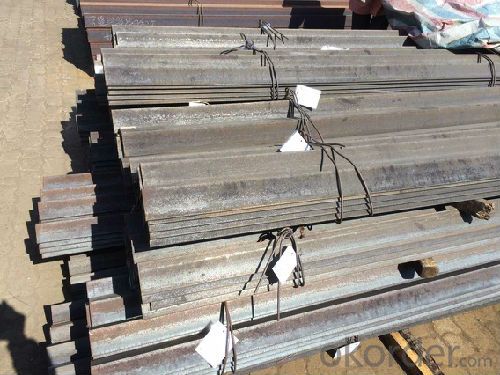
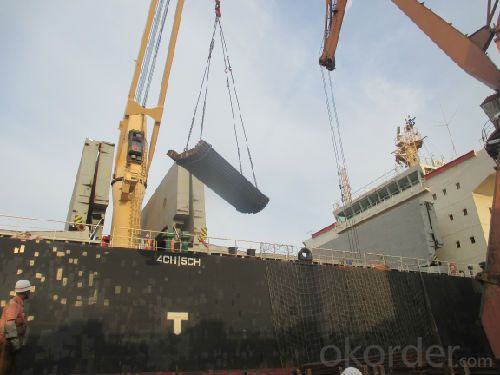
- Q:How do you determine the required angle size for a specific load?
- To determine the required angle size for a specific load, several factors need to be considered. Firstly, the weight of the load must be determined. This can be done by measuring the mass of the object or by consulting relevant engineering specifications. Secondly, the angle of inclination or the slope at which the load will be placed needs to be known. The angle of inclination will affect the force exerted on the angle, as well as the stability of the load. Next, the type and material of the angle being used should be considered. Different materials have different load-bearing capacities, and the type of angle (e.g., steel, aluminum, or wood) will dictate the maximum load it can support. Additionally, the length of the angle and the number of supporting points should be taken into account. Longer angles may require additional support to distribute the load evenly and prevent bending or deformation. Once all these factors are determined, calculations can be made using engineering formulas and principles. These calculations will consider the weight of the load, the angle of inclination, and the material properties of the angle to determine the required angle size. It is important to note that when designing for safety, engineers usually include a factor of safety to ensure the angle can handle loads beyond the expected maximum. This factor accounts for variables such as dynamic loads, unforeseen circumstances, and wear and tear over time. In conclusion, determining the required angle size for a specific load involves considering the weight of the load, the angle of inclination, the material properties of the angle, the length of the angle, and the number of supporting points. Through calculations and incorporating a factor of safety, the appropriate angle size can be determined to ensure the load is supported safely and effectively.
- Q:What is the process of galvanizing steel angles?
- The process of galvanizing steel angles involves several steps to ensure the steel angles are coated with a layer of zinc for protection against corrosion. Firstly, the steel angles are cleaned to remove any dirt, oil, or rust from the surface. This is typically done through a process called pickling, where the angles are immersed in a solution of acid, usually hydrochloric acid, to remove any impurities. Once the steel angles are cleaned, they are then rinsed to remove any residual acid and dried thoroughly. This is important to ensure proper adhesion of the zinc coating. After the cleaning process, the steel angles are dipped into a bath containing molten zinc. This is done through a process called hot-dip galvanizing, where the angles are fully immersed in the zinc bath. The temperature of the zinc bath is typically around 840°F (449°C). As the steel angles are immersed in the zinc bath, a metallurgical reaction occurs between the steel and the molten zinc. This reaction forms a layer of zinc-iron alloy on the surface of the angles. This layer provides excellent corrosion resistance and acts as a barrier between the steel and the corrosive elements in the environment. After the angles have been fully immersed in the zinc bath, they are then removed and allowed to cool. The cooling process solidifies the zinc coating and ensures its adhesion to the steel angles. Finally, the galvanized steel angles are inspected for quality control. This includes checking the coating thickness, uniformity, and adherence to the angles. Various tests and measurements are performed to ensure that the galvanized coating meets the required standards and specifications. Overall, the process of galvanizing steel angles involves cleaning, immersion in a molten zinc bath, cooling, and inspection. This process provides a durable and long-lasting protective coating on the steel angles, making them resistant to corrosion and extending their lifespan.
- Q:What are the design standards for steel angles?
- The specific application and industry requirements determine the design standards for steel angles. However, in the construction and engineering fields, there are commonly followed general design standards. The dimensional and mechanical properties of the steel angles are an important aspect. These properties encompass the angle's size, thickness, length, and weight. Typically, the dimensions are specified in millimeters or inches, while the mechanical properties determine the angle's strength and load-bearing capacity. Steel angles usually have an L-shaped shape, with legs that can be equal or unequal in length. Equal-legged angles have two legs of the same length, while unequal-legged angles have two legs of different lengths. The shape and geometry of the angle play a critical role in determining its structural integrity and stability. Another crucial consideration is the material specification for the steel angles. The material used for fabrication must meet specific standards, such as those set by the American Society for Testing and Materials (ASTM). This ensures the required strength, ductility, and toughness. Carbon steel, stainless steel, and alloy steel are commonly used materials for steel angles. Connection details are also included in the design standards for steel angles. These details specify how the angles are connected to other structural members, such as beams, columns, or plates. The connection method ensures proper load transfer and structural stability. It may involve welding, bolting, or other mechanical fastening methods. Furthermore, design standards may provide guidelines for the design of steel angle members subjected to specific loads, such as axial compression, bending, or shear. These guidelines include formulas, charts, and design tables that allow engineers to calculate the required size and strength of the angle based on the applied loads and other factors. In conclusion, the design standards for steel angles ensure that these structural members meet specific requirements in terms of dimensions, material properties, shape, and connection details. These standards are crucial for ensuring the safety, reliability, and performance of steel angles in various applications, ranging from building construction to industrial machinery.
- Q:Can steel angles be used for structural support?
- Indeed, steel angles can serve as a means of providing structural support. Construction and engineering endeavors frequently employ steel angles in order to furnish structures with the necessary support and stability. Their application is particularly common in the construction of buildings, bridges, and various other forms of infrastructure. Steel angles possess strength and durability, rendering them suitable for bearing substantial loads and withstanding the forces of compression and tension. Furthermore, their L-shaped design facilitates effortless installation and connection to additional structural elements. By employing steel angles as beams, columns, braces, and other structural components, it is possible to endow a structure with both stability and strength.
- Q:What are the different methods of protecting steel angles against corrosion?
- There are several methods available to protect steel angles against corrosion. These include applying a protective coating such as paint or powder coating, using galvanization to create a zinc barrier, applying a corrosion-resistant primer, using stainless steel angles, or implementing cathodic protection systems. Each method has its own advantages and suitability depending on the specific application and environmental conditions.
- Q:What is the use of angle steel and channel steel?
- Most of the channels are made of trays and cabinets, as well as stationary supports, such as power plants and substations.
- Q:How do steel angles perform under lateral or wind loading conditions?
- Steel angles are commonly used in construction for their ability to withstand lateral or wind loading conditions. Due to their shape and structural design, steel angles offer excellent resistance against bending and twisting forces. They distribute the applied loads efficiently, ensuring stability and minimizing any potential structural damage. Overall, steel angles are reliable and perform exceptionally well under lateral or wind loading conditions.
- Q:Can steel angles be used in mezzanine flooring systems?
- Indeed, mezzanine flooring systems can incorporate steel angles. In the realm of mezzanine construction, steel angles are frequently employed as structural components due to their remarkable robustness and longevity. Whether utilized as supports, beams, or bracing elements, steel angles offer stability and an impressive load-bearing capacity to mezzanine flooring systems. Moreover, steel angles are adaptable and can be readily tailored and installed to meet precise design specifications. Additionally, they present a cost-effective and dependable solution for generating extra floor area in industrial and commercial edifices.
- Q:How do steel angles perform in cold weather conditions?
- Steel angles perform well in cold weather conditions due to their high durability and strength. The properties of steel, such as its ability to withstand extreme temperatures and resist deformation, make it an ideal material for various applications in cold environments. Steel angles are commonly used in construction, infrastructure, and manufacturing industries, where they provide structural support and stability. In cold weather, steel angles maintain their structural integrity, ensuring the safety and longevity of the structures they are used in. Additionally, steel has a low thermal expansion coefficient, meaning it does not contract or expand significantly with temperature changes, making it less susceptible to warping or cracking in freezing conditions. Overall, steel angles are a reliable choice for cold weather conditions, offering excellent performance and reliability.
- Q:How do steel angles perform in terms of thermal expansion and contraction?
- Steel angles have a relatively low coefficient of thermal expansion, which means they expand and contract less compared to other materials when subjected to temperature changes. This property makes steel angles highly stable in terms of thermal expansion and contraction. Consequently, they are widely used in various structural applications where temperature variations are expected. Steel angles provide structural integrity and stability, even in environments with significant temperature fluctuations, making them a reliable choice for construction and engineering projects.
1. Manufacturer Overview |
|
|---|---|
| Location | |
| Year Established | |
| Annual Output Value | |
| Main Markets | |
| Company Certifications | |
2. Manufacturer Certificates |
|
|---|---|
| a) Certification Name | |
| Range | |
| Reference | |
| Validity Period | |
3. Manufacturer Capability |
|
|---|---|
| a)Trade Capacity | |
| Nearest Port | |
| Export Percentage | |
| No.of Employees in Trade Department | |
| Language Spoken: | |
| b)Factory Information | |
| Factory Size: | |
| No. of Production Lines | |
| Contract Manufacturing | |
| Product Price Range | |
Send your message to us
High Quality Steel Angle Beams for Structure of Construction
- Loading Port:
- Tianjin
- Payment Terms:
- TT or LC
- Min Order Qty:
- 25 m.t.
- Supply Capability:
- 200000 m.t./month
OKorder Service Pledge
OKorder Financial Service
Similar products
New products
Hot products
Related keywords
